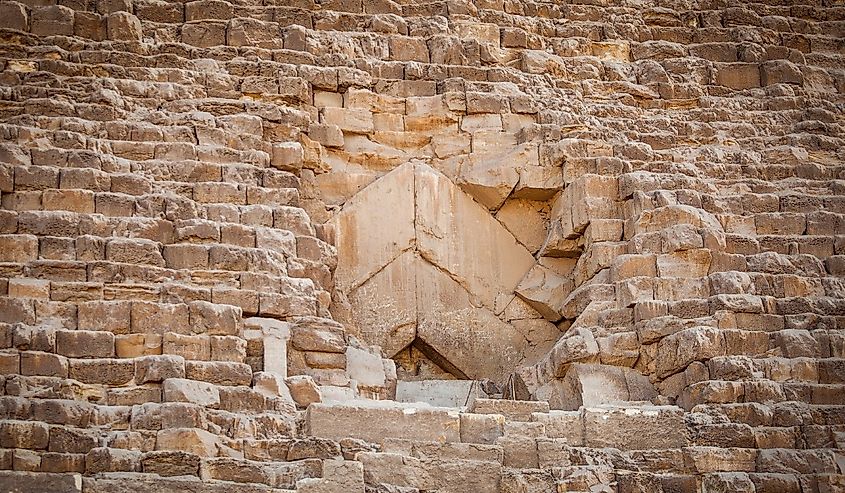
Exploring The Great Pyramid Void
There are pyramids all over: Egypt, Sudan, Mexico, Peru, and China — among other countries. Then there is the Great Pyramid of Giza, considered among the Seven Wonders of the World — and the last of the wonders still standing. The Pyramid of Giza is among the finest exhibits of human genius anywhere on the planet. It once stood at about 482 feet, and has endured more than 4,500 winters remarkably well. It is still a mystery how the ancients built the Great Pyramid without the technological advancements that this generation justifiably flaunts. However, fresh details have emerged concerning a void in the Great Pyramid scientists first discovered in 2017.
The Mystery of the Great Pyramid’s Void

Voids have an element of fascination. Whether that be the cosmic’s Great Nothing — or the mysterious void in Ancient Egypt’s Great Pyramid of Giza. And true to expectation, everyone's interest was piqued when scientists discovered what they were careful to call a "void" inside the Great Pyramid in 2017. At the time, however, there were scant details about the void, its shape and size — and its general design. Among the few things scientists could state with a measure of certainty was that the void was above the Grand Gallery. The Grand Gallery is the 28-foot-high imposing passageway that leads to the King’s Chamber, and which, for its astonishing corbelled ceiling, has no equal in internal passages of pyramid tombs.
Using Muon technology, scientists involved in a project called ScanPyramids now estimate that the void spans a length of about 30 feet. As to the void’s height and width, scientists estimate that both are approximately 6.5 feet. The void, according to Scan Pyramid scientists, is shaped like a corridor, almost similar in design to the Grand Gallery. This is the first major internal discovery in the world-famous pyramid since the 19th century.
Purpose of the Void

While several theories have been advanced, scientists on the project are still not certain about the purpose of the Great Pyramid’s void. A University of Cambridge archaeologist with an interest in Ancient Egypt, for instance, suggests that the void may have been used to transport the huge blocks that form the roof of the chambers above where the second pharaoh of Ancient Egypt’s Fourth Dynasty was laid to rest. If this hypothesis holds true, then the void might have a ramp or ramp-like structure — used to move the heavy roof blocks into place — and which was eventually left unfilled. This hypothesis is further lent credibility by the fact it is directly above the Grand Gallery.
Another suggestion is that the void inside the last of the Ancient Wonders of the World still standing, may have served as a secret burial chamber of Pharaoh Khufu. This particular theory is famous because people are eager to latch on to something with an aura of secrecy and a dash of conspiracy. While this theory often gets currency with the media and general public because of its speculative value, scientists working on the project have been reluctant to give credence to this hypothesis.
Another hypothesis is that the Great Pyramid’s void was a built-in structural support to lessen the weight on the Grand Gallery. On closer scrutiny, however, this hypothesis does not appear to hold water. If anything, the distance between the void and the gallery is so spaced-out as to suggest any kind of structural support. Other fringe suggestions include the idea that the void was a normal passage the builders used to move around — or an ancient anti-seismic device. It may be many more years before they know for sure, if at all.
The Muon Technology

The interior of the Great Pyramid has always intrigued humans. However, because of technological limitations, it has not always been possible to look inside. The void, for instance, is not accessible as it is encased within a large mass of impenetrable rock. But thanks to Muon technology, scientists can look at what lies inside one of the most famous architectural marvels on Earth.
For perspective, muons are subatomic particles emitted when cosmic rays enter the Earth’s upper atmosphere. Scientists placed muon detectors inside the pyramids to monitor the movement of muons. Through this, scientists are able to figure out the nature of a mass, whether void or solid — as well as its depth and density. Since muons pass more easily through empty spaces than through solid structures, scientists are able to map a structure with considerable accuracy.
The Takeaway
There are a few man-made structures that have spawned fascination, interest, almost obsession — such as the Pyramids of Giza. People have wondered how they were built, who built them, and what motivated the builders. On the exterior, they look imposing and grand, viewed as enduring emblems of human genius. But people have also wanted to know what lay inside the pyramids. Today, thanks to cutting-edge imaging technologies, scientists have observed a major void located just above the pyramid’s Grand Gallery. Despite the new discovery, there are still many questions surrounding the void's purpose. That said, if technological progress is anything to go by, brace for other ground-breaking discoveries regarding one of the Seven Wonders of the World.











